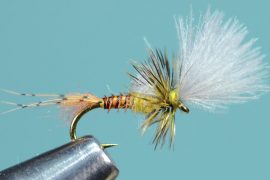This past June, Secretary of Commerce Wilbur Ross named Chris Oliver as assistant administrator for NOAA Fisheries. His responsibility is overseeing the National Marine Fisheries Service.
Oliver brings more direct fisheries-management experience to the role than some other recent appointees to head NMFS. The Texas native spent the past 27 years working with the North Pacific Fishery Management Council, first as a fisheries biologist, then deputy director and — for the past 16 years — as the council’s director.
Despite his experience, Oliver’s direction on policy matters of importance to the nation’s recreational anglers and attendant industries have not been well known. It’s the purpose of this exclusive interview to change that and begin to establish an idea of what we might expect from the latest head of NMFS.

Management Strategies, Commercial Vs. Recreational
SPORT FISHING:
Do you feel that commercial fisheries and recreational fisheries can and/or should be managed by NMFS with the same fundamental approach, or that very different management strategies are required for each? As a fisheries manager, what differences, if any, do you see between the way these two stakeholder groups use a resource that would or should require different management strategies?
CHRIS OLIVER:
First, thanks for the opportunity to share my thoughts with your readers. I am still getting my sea-legs here at NOAA Fisheries, but my experience in Alaska gave me a solid foundation for tackling the issues that concern both our recreational and commercial fishermen on a national level.
So, on to your questions. I think we can agree that commercial and recreational fishing are different, but both share the common need for sustainable, science-based management and access, and both are subject to the requirements of the Magnuson-Stevens Act. As businesses, commercial fishermen appropriately seek to harvest fish as quickly and efficiently as possible, minimizing costs and maximizing profits. Recreational anglers, on the other hand, fish to enjoy time on the water or spend time with family and friends. I believe we need to recognize these differences and, where appropriate, use different management approaches to ensure both communities thrive.
It think it is important to note that the Magnuson-Stevens Act was originally crafted as a commercial statute to Americanize fisheries occurring just off our shores and expand our domestic commercial fisheries – and it worked. However, applying the same tools used to achieve those goals and, more recently, rebuild depleted fish stocks, may not translate into successful management of recreational fisheries. Recognizing this, NOAA Fisheries was able to address a number of issues important to the recreational community, as well as the commercial fishing community, by adding additional flexibility for fishery managers as we revised the National Standard 1 Guidelines in 2016. This included greater flexibility to carry-over unused quota from one season to the next, use multi-year overfishing definitions, and determine rebuilding timelines, among others. More about National Standard 1 revisions can be found on our website.
NMFS Priorities in Managing Fisheries
SPORT FISHING:
As a follow-up to that question: Managing recreational fisheries was added to the responsibilities of this Department of Commerce agency long after it was created, primarily to look after the welfare of commercial fishing/fishermen in this country. In other words, managing recreational fisheries was an afterthought, and some insist that it still is, with NMFS committing neither effort nor funds necessary to manage recreational fisheries as effectively as it manages commercial fishing. To what extent do you feel that is a fair criticism?
CHRIS OLIVER:
I am glad you raised that question because I believe the criticism is outdated. The Magnuson-Stevens Act expressly acknowledges as one of its key purposes that “commercial and recreational fishing constitutes a major source of employment and contributes significantly to the economy of the Nation” and includes “promot[ion] of domestic commercial and recreational fishing under sound conservation and management principles….” My predecessors in this role took this seriously and I do, too. I believe NOAA Fisheries has made remarkable progress these past few years in focusing on building stronger relationships and greater capacity to help the recreational community. One good example is the appointment in 2010 of our national recreational fishing coordinator, Russ Dunn. His sole focus is to understand the needs of the recreational sector and ensure those needs are heard and considered at the highest levels of the agency.
I would also point out that recreational fishing is fully incorporated into the agency’s science and management programs through our National Saltwater Recreational Fisheries Policy. We also have national and region-specific recreational fisheries implementation plans with nearly 300 public commitments included, many of which have been accomplished or are underway. I am committed to continuing an open, face-to-face dialogue with leaders in the saltwater fishing community. To that point, I am pleased to share with your readers that we will host a second National Saltwater Recreational Fisheries Summit in Virginia in March 2018. The current Administration recognizes the importance of recreational fisheries and has made it a high priority to develop management programs appropriate to support those fisheries.
U.S. Department of the Interior Vs. Department of Commerce to Manage Recreational Fisheries?
SPORT FISHING:
And as another follow-up: Why is NMFS better off under the U.S. Department of Commerce umbrella vs. the U.S. Department of the Interior (which includes several federal agencies with responsibilities for managing fish and wildlife)?
CHRIS OLIVER:
The core mission of the Department of Commerce—promoting American business—makes it well suited to bolster the economic benefits of saltwater recreational fisheries. In 2015, spending on saltwater recreational fishing supported 439,000 jobs, drove $63 billion in sales impacts, and contributed $36 billion to the national gross domestic product. Each of these economic markers has steadily increased since 2012, showing the positive effects of rebuilding overfished stocks. The Department of Commerce and NOAA understand that recreational fishing is big business and are committed to continuing this positive trend.
Also, the successful management of our oceans, coasts, and marine resources—including fisheries—requires highly integrated information-sharing and decision-making with partners at every level. NOAA has an institutional capacity and infrastructure unlike any other, enabling it to collect and analyze needed oceanographic and biological information. This comprehensive and robust marine fisheries science capacity does not exist within Interior, and it allows NOAA Fisheries, in conjunction with our state and federal partners, to better meet our mandates under the law.
Would Changes to MSA Empty the Oceans of Fish?
SPORT FISHING:
Recently, legislation has been working its way through both houses that would amend federal fisheries law (the Magnuson-Stevens Act, or MSA) in a way that recreational fishing interests would say finally recognizes their needs without removing built-in safeguards for marine fish stocks. However, some environmental groups insist such changes to the MSA would “empty the oceans” of fish. What are your thoughts on…





